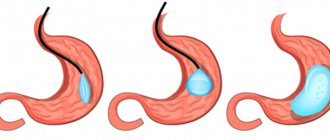Bariatric surgery, whose world history has crossed the eighth decade, continues to develop rapidly. According to the best bariatric surgeons on the planet, the expression “there is no limit to perfection” could not be more suitable for obesity surgery.
Leading specialists of the Clinical Center for Surgery of Weight and Metabolic Disorders in Moscow, Professor V.V. Fedenko and Dr. V.V. Evdoshenko are bright representatives of the elite of world bariatric surgery. Having started working in this direction back in the 90s of the last century, they improved almost all classical restrictive and malabsorptive interventions, increasing their effectiveness and safety. What remains unchanged is their commitment to minimally invasive laparoscopic techniques, in which they are true virtuosos and have performed more than 5 thousand bariatric interventions.
Sleeve gastroplasty in 2021
Sleeve gastroplasty is a restrictive operation. Its essence lies in a sharp reduction in the volume of the stomach by removing its bottom and most of the body. According to its slight curvature, a narrow tube is formed that can accommodate a minimum amount of food. Slowly moving along this “sleeve”, it irritates the receptors that perceive pressure. They send signals to the brain about satiety, as a result a person loses up to 80% of excess weight without suffering from hunger.
Professor V.V. Fedenko and V.V. Evdoshenko has been performing sleeve gastroplasty for about 15 years. However, the disadvantages of its classic version (the risk of suture failure, “sleeve” obstruction, and hiatal hernia formation) prompted them to significantly modify the surgical technique. Today, sleeve gastroplasty performed by them is:
- Absolutely smooth, without contractions or expansions of the gastric “sleeve”;
- preservation of the abdominal (abdominal) part of the esophagus;
- fixation of the “sleeve” to the ligaments inside the abdominal cavity;
- reinforcement of the staple seam by surface coagulation;
- preventive sutures that prevent the formation of a hiatal hernia.
How dangerous is sleeve resection?
Some patients directly ask whether they will become disabled after RG.
In an uncomplicated postoperative course, RG does not lead to disability. On the contrary, as they lose body weight, patients are able to live and work normally, get rid of many diseases associated with obesity, and transition to a new quality of life. This is true for any bariatric surgery. It is appropriate to recall here that obesity itself, if treated ineffectively, is a disabling disease.
It is impossible to guarantee the absence of complications with any operation. With RG, a staple suture is placed along the entire stomach. Although these sutures are performed using high-quality staplers and are always reinforced, there is still a small risk of postoperative bleeding, as well as failure (cutting through) of some sutures, which in rare cases may require laparoscopic or surgical revision. To prevent suture insufficiency in the first two weeks after prostate cancer, nutrition should be in liquid form, without undue stress on the gastric sutures. Since the operation takes place in the area of the splenic hilum, we always warn that if significant bleeding occurs from the spleen, it may be removed. We also warn about this during other gastric surgeries performed due to obesity.
In addition to antiulcer medications in the first 2–3 months, it may be necessary to prescribe multivitamins (“”) during the period of intense weight loss . The need for other medications will be determined by the results of blood tests, which will need to be performed periodically. Patients who are planning pregnancy (possible only after completing weight loss) need to take folic acid throughout the entire period of pregnancy.
About 65% and 75% of excess weight is lost within the first year. The average weight loss is 45–60 kg, which means that the surgery is suitable for people with a body mass index of 40–45. A sleeve gastrectomy is less likely to fail than a gastric ring. About 88% of patients are satisfied with the results of the procedures.
Gastrobypass surgery in 2021
Gastric bypass, or gastric bypass, is one of the most powerful and popular operations in modern weight surgery. It allows you not only to reliably eliminate up to 90% of extra pounds, but also to cure type 2 diabetes.
Gastrobypass surgery combines:
- restrictive (limiting) mechanism, since the gastric reservoir is reduced to the size of a small pouch cut from the upper part of the lesser curvature of the stomach;
- malabsorptive mechanism, since a decrease in food absorption is ensured by disconnecting up to a third of the length of the small intestine from the process of its digestion.
In the classical version, gastric bypass was an operation with two anastomoses - gastrointestinal and small-intestinal. More than 15 years ago, it was modified into a better version involving the creation of a single anastomosis - the OAGB procedure.
Our surgeons V.V. Fedenko and V.V. Evdoshenko developed several fundamentally new, key techniques that significantly improved the long-term results of gastric bypass surgery. This:
- the formation of a retrocolic anastomosis between the stomach and the small intestine instead of the anterior colon one used before, which threatens complications due to the tension of the small intestinal loop;
- transition from gastrointestinal anastomosis using the “side to side” method to the “end to side” method, which eliminates the reflux of intestinal contents into the stomach;
- the use of smaller templates to form the intestinal tube, which increased the restrictive effect of the operation.
Gastric banding in 2021
Gastric banding is a restrictive bariatric procedure. It differs from all others in that limiting the intake of food is achieved not by restructuring the gastrointestinal tract, but by installing a special device in its upper sections - a bandage. One of its main components is a hollow, closed cuff that can be filled with fluid through an adjustable subcutaneous port, thereby determining the degree of narrowing of the opening for food to enter the stomach. The narrower it is, the greater the pressure on the esophageal receptors, which notify the brain of satiety.
Despite all the advantages, gastric banding in its original form also has serious disadvantages. In particular, the bandage can migrate, and the connecting tube connecting it to the adjustment port can create conditions for intestinal strangulation with the development of intestinal obstruction.
Professor V.V. Fedenko and V.V. Evdoshenko improved the classical technique, and now gastric banding is as safe as possible. In their modification:
- the bandage is applied high, at the junction of the esophagus and the stomach, so the latter is not overtightened and is not injured;
- the bandage is not sewn to the stomach, but is fixed solely due to its location using a new technique - between the wall of the stomach and the peritoneum;
- the connecting tube does not move freely in the abdominal cavity, threatening to strangulate the intestine, but is firmly fixed in the tissues under the peritoneum.
Bypass drain in 2021
Bypass drainage, or short-loop gastric bypass, is a technique developed by bariatric surgeons V.V. Fedenko and V.V. Evdoshenko based on the technique of sleeve gastroplasty, gastric bypass with one anastomosis and their own previous development - the formation of a retrocolic gastrointestinal anastomosis. The technology for creating this anastomosis makes it possible to form not only a long loop of the small intestine, as with Roux-en-Y gastric bypass, but a very short one, only 20 cm, which does not affect the absorption of food.
Thus, a fundamentally new operation was created - bypass in its technology, since an anastomosis (shunt) is created between the stomach and the small intestine, but absolutely restrictive in essence, like a sleeve gastroplasty.
This intervention made it possible to eliminate as much as possible all the disadvantages of sleeve gastroplasty, practically without interfering with the physiological processes of food digestion.
Important
Surgical treatment of obesity is indicated:
► if excess body weight exceeds 45 kg compared to the norm; ► with a body mass index (BMI) of more than 40 kg/m2, as well as with a BMI of more than 35 kg/m2 and the presence of serious diseases associated with obesity; ► if previous conservative treatment did not provide the desired effect.
Surgical treatment of obesity is contraindicated in:
► exacerbation of peptic ulcer of the stomach and duodenum; ► cancer; ► severe irreversible changes in vital organs.
Biliopancreatic bypass in 2021
Dr. Evdoshenko V.V.
Biliopancreatic bypass in 2021 is performed in the modern version of SADI. It differs from the original version in a longer section of the small intestine involved in the absorption of food - 2.5 m versus 0.7-1 m in the outdated version. This made it possible to reduce the negative consequences of too strong a malabsorptive component.
And so that the operation does not lose its effectiveness, now at its first stage a full-fledged sleeve gastroplasty is performed with the formation of a very narrow “ventricle-sleeve”, while in the classical version the stomach remained wider and the restrictive component was not so noticeable.
Professors V.V. Fedenko and V.V. Evdoshenko are the only Russian surgeons who perform the most complex SADI biliopancreatic bypass surgery using the laparoscopic method. The benefits of this for a superobese patient, where surgical risks are obviously high, cannot be overestimated.
Repeated bariatric surgeries in 2021
Repeated bariatric surgery may be required if the first one no longer serves its purpose and the patient begins to gain weight again. Sometimes this happens due to a violation of the recommended dietary regimen, sometimes because the bariatric surgery itself has become less effective. The last reason is not at all uncommon, since any surgical reconstruction of the gastrointestinal tract, by definition, cannot be not only better, but even at the level originally created by nature. Therefore, repeated bariatric interventions have been developed to eliminate disorders that appeared some time after the first operation.
At the Clinical Center, surgery for weight and metabolic disorders is performed after:
- gastric banding – Roux-en-Y gastric bypass, mini-gastrobypass, SADI biliopancreatic bypass;
- Sleeve gastroplasty – strengthening of the stomach wall “sleeve” with “Permacol”, Roux-en-Y gastric bypass, biliopancreatic bypass SADI;
- gastric bypass - installation of a non-adjustable band, strengthening the wall of the “small ventricle” with Permacol, distal gastric bypass (lengthening the Roux branch);
- biliopancreatic bypass - strengthening the wall of the gastric tube with Permacol, transferring the anastomosis, eliminating a hiatal hernia.
Of course, during repeated bariatric surgeries, all the improvements in classical techniques developed by Professors V.V. are used. Fedenko and V.V. Evdoshenko, increasing their effectiveness and safety, including the widespread use of the absorbable biocollagen mesh "Permacol".
The desire of bariatric surgeons to make interventions even more effective, safe and functional motivates them to develop new approaches and techniques in weight surgery. Therefore, the face of bariatric surgery is rapidly changing and becoming more attractive every year.
Outdated types of operations
Intragastric balloon
This technique refers to minimally invasive manipulations. It is identical in complexity to conventional gastroscopy. Under the control of an endoscope, a special balloon is installed in the stomach, which is filled with 400-600 ml of liquid and remains in the lumen of the stomach, thereby reducing its volume.
The course of treatment is 4-6 months. Cylinders can be reinstalled. Removing the balloon is a slightly more complex procedure that requires anesthesia.
Currently, the use of this type of treatment is limited and is limited to the stage of preparing patients for more serious types of bariatric surgery.
pros
- Non-invasiveness of the technique
Minuses
- Body weight loss occurs within 6 months, then weight gain resumes
Gastric band
This type of surgical treatment is an organ-preserving operation. The essence of the technique is that, under video control (laparoscopically), through small punctures on the anterior abdominal wall, an adjustable band is installed on the stomach, which is made of biologically inert material (silicone), which limits the amount of food consumed.
This is achieved by creating a “small ventricle” with a volume of 5 to 15 ml using an adjustable banding system. After this treatment, the amount of food consumed is reduced several times, and the energy value of the daily diet is 800-1500 kcal.
Currently, the use of this type of surgical treatment of obesity is limited due to its high cost and low effectiveness.
pros
- Controllability of the technique
- Technical simplicity
Minuses
- High price of consumables
- Dependence on the doctor - the need to adjust the bandage in a clinical setting
Sleeve gastroplasty is considered the most accessible and effective method of surgical weight loss. The result after this operation is lasting, the patient’s adaptation to a new model of eating behavior occurs quite quickly. And weight loss occurs gradually, allowing one to get used to a new lifestyle. Modern surgical methods for treating obesity give many people a second life. They help get rid of a huge number of complexes that, like usually accumulate along with extra pounds, arrange your personal life and improve your career. A person gets the opportunity to play sports, easily tolerate physical activity in everyday life, and learn proper eating behavior.
Our clinic has accumulated vast experience in performing various operations in the treatment of morbid obesity. The operation is performed by surgeons with extensive work experience and experience in performing endovideosurgical operations.











